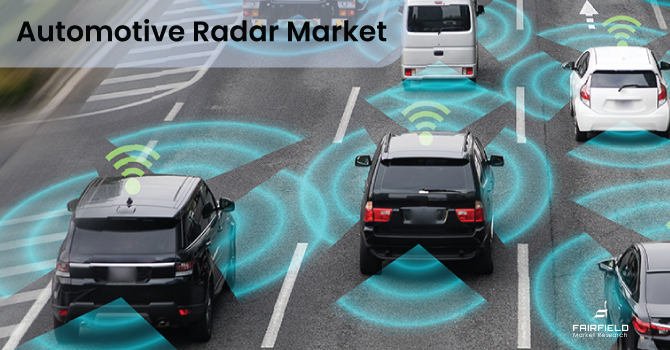The global automotive radar market is set to experience significant growth driven by increasing road safety concerns, advancements in technology, and the rising demand for premium vehicles. According to the World Health Organization, approximately 1.35 million people die annually due to road crashes, with predictions indicating that road traffic crashes will become the seventh leading cause of death by 2030. The African region exhibits the highest road traffic fatality rate at 26.6, compared to 9.3 in Europe. This alarming statistic underscores the urgent need for advanced safety systems, including automotive radars, to enhance road safety globally.
For More Industry Insight: https://www.fairfieldmarketresearch.com/report/automotive-radar-market
Rising Consumer Awareness and Safety Demands
With growing awareness about road traffic injuries, consumers are placing a higher emphasis on vehicle safety. The demand for safety features in automobiles has surged as passengers and pedestrians increasingly prioritize safety. Improved financial capabilities and shifting lifestyle preferences are accelerating the growth of the automotive radar market. As consumers seek vehicles equipped with advanced safety features, automakers are responding by integrating technologies that enhance vehicle safety and performance.
Surge in Premium Vehicle Demand
The demand for premium vehicles is anticipated to reach $566 billion by 2026, fueled by favorable financial schemes available for premium segment cars. The Organization of Motor Vehicle (OICA) reports that banks and financial institutions are now offering up to 100% funding for new car loans, further driving the growth of the premium vehicle market. This surge in premium car sales is expected to boost the automotive radar market, as premium vehicles increasingly incorporate radar systems for enhanced safety features.
Impact of Urbanization and Commutation Trends
The rise of urban sprawl and the development of hub-and-spoke architecture have led to increased commutation between rural and urban areas. According to OICA, 5,934,467 new vehicles were registered in 2021 even before the first quarter ended. Many modern vehicles now come equipped with advanced safety features such as adaptive cruise control and autonomous emergency braking. These features are significantly contributing to the growth of the automotive radar market, as consumers demand more sophisticated safety solutions.
Technological Advancements Driving Market Growth
Technological advancements, including the integration of Artificial Intelligence (AI) in electronic components like lidar and automotive radar, are enhancing vehicle safety. The rise of wireless communication, park assistance, safety alarms, and collision avoidance systems is increasing the importance of ultrasonic and proximity sensors. Applications such as adaptive cruise control (ACC), blind spot detection, and lane change assist are becoming more popular, driving sustained growth in the non-imaging radar sector. These innovations are expected to boost the automotive radar market by improving safety and performance.
Challenges Facing the Automotive Radar Market
Despite the positive outlook, the automotive radar market faces challenges. High installation costs for premium radar systems increase the overall price of vehicles, potentially hindering market growth. Additionally, the complexity of maintaining these systems and the need for skilled technicians can deter consumers. The COVID-19 pandemic and subsequent lockdowns also impacted the automotive industry, slowing the demand for advanced vehicle technologies. As the industry recovers and consumer spending stabilizes, growth in automotive radar adoption is expected to resume.
Regulatory Influence and Regional Market Dynamics
Favorable government regulations in Europe are driving the growth of the automotive radar market in the region. The stringent vehicle safety standards set by the European Commission are contributing to the market’s expansion. The increasing availability of premium vehicles across Europe is further supporting market growth. Meanwhile, the Asia-Pacific region is also expected to see notable developments in automotive radar, driven by rising vehicle sales and growing consumer awareness in developing countries.
Long-Range Radars and Autonomous Emergency Braking
The automotive radar market is segmented by radar range, including medium-range and long-range radars, as well as frequency bands such as 24 GHz and 79 GHz. Medium-range radars are in high demand for safety systems like park assists and traffic alerts. Long-range radars, used primarily for adaptive cruise control (ACC), are expected to see increased adoption in mid- and entry-level cars. Radar systems operating at 79 GHz are anticipated to dominate the market due to their capabilities in blind spot monitoring and comprehensive vehicle surroundings mapping.
Passenger Vehicles and Commercial Vehicle Growth
The passenger car segment has experienced a 4.5% growth from 2015 to 2016, driven by increased road safety awareness among mid-level car owners. As more passenger cars are equipped with radar systems, the market for automotive radar is projected to grow further. The expansion of e-commerce and logistical developments will also drive growth in the commercial vehicle sector. The rise in vehicle autonomy in commercial vehicles will contribute to increased demand in this segment.
Key Industry Players and Future Developments
Leading players in the automotive radar market, including NXP Semiconductors, Robert Bosch GmbH, Autoliv Inc., and Continental AG, are focusing on developing compact and high-performance radar systems. The market is witnessing inter-country partnerships, such as the collaboration between NXP Semiconductors and Hawkeye Technology, which could boost global market growth. Similarly, partnerships like Audi and Aptiv’s domain controller for front sensors highlight the industry’s focus on advanced radar technologies. These developments are expected to accelerate the adoption of automotive radar systems and enhance their performance.


